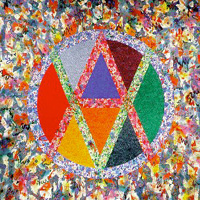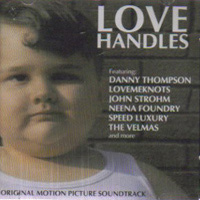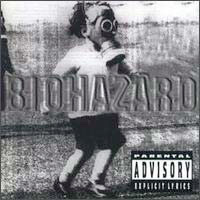 Afro Celt Sound System
Afro Celt Sound System
Volume 1 Sound Magic (Real World)
An interview with Simon Emmerson (programming/production), Iarla Ó Lionáird (vocals), and James McNally (whistles)
by Clarendon Lavorich
One usually doesn’t fit Celtic folk music, African folk music, and laid-back dance music all together in the same album, much less the same track! But that’s what Afro Celt Sound System has done. Imagine an easy going Dub utilizing instruments such as Kora, Talking Drums, Uillean Pipes, Doudouk, Flutes, Celtic Harp, Mandolin, Bohdran, Fiddle, and Electronic Programming. Now imagine all of this fitting together seamlessly to create a hybrid sound. Even the typical Real World logo (different colors representing what nation the music is from) is blended together, indicating that this is truly the work of a new culture. Employed in the album design for Volume 1: Sound Magic is a unicursive hexagram – the hexagram indicating the alchemical sign of the blending of opposites, and the fact that it’s unicursive (which means you don’t have to pick up your pencil to draw it) showing the unity of the musics. At times it’s mellow and easy, like on “Saor/Free,” which effortlessly blends the mellow sounds of a wood flute with the firm bass of a Dub shuffle, and at other times wild and frantic, like “Whirl-y-Reel,” a whistle and fiddle folk dance tune that really makes the sap in your feet rise. I found time to chat with them. Nice guys.
How did this all come about?
Simon: It naturally sprung to my mind, which probably says more about me than anything. It came to me 4 years ago in Senegal when I was working with a West African singer, Baaba Maal. Celtic musicians have always felt an affinity with African music, West African particularly. I think there is a link, I’d go so far as to say it’s one that goes back thousands of years. What we’ve done is not original in the sense that I believe Celtic Harp and Talking Drum have met before.
James: I grew up playing Irish music in London, which started me off on the journey to the Afro-Celts. It was quite natural, after playing in the Marksmen and in the Pogues, to experiment with this stuff. I hope we inspire other collaborations, because it’s beautiful. With modern communication and travel, it’s inevitable. It’s the future.
Airla: When I talked to Simon, I asked not to hear any of the preparatory tapes, that it would be better just to go into the studio and to see if the chemistry would happen. I found the African rhythms fit in very well with what I was doing as a solo singer.
What languages are being used?
Airla: Three, including English. My first language is Gaelic, but I hadn’t written many songs in it before. It was quite easy to respond to what was going on. I felt quite at home in that soundscape.
Do you sing in African on any of the tracks?
Airla: No, but it’s starting to happen in the live work. I read a review of one of our shows that said one tune sounded like a Moorish call to prayer.
Simon: When Baaba Maal heard the Uillean Pipes he said they sounded like his ancient people’s music. They were from North Africa, and were nomadic. So were the Celts. It seems that the music of wandering tribes contains a lot of quarter tones and sliding notes, unlike the European obsession with harmonies and mathematical melodies. The nomadic music doesn’t count bars, they don’t have choruses. It has very little to do with Western European classical music.
In addition to African and Celtic music, you use drum ‘n’ bass on a tune, and use dance floor electronics throughout.
Simon: That’s my folk tradition (laughs). I went to a musicology seminar and these people were searching for a generic music of Kenya or whatever, and I was thinking, “You only need to go four miles up the road to find a generic music form. It’s Drum ‘n’ Bass!” If you go to Senegal, they essentially play all-night Drum ‘n’ Bass Sessions! I’m really excited about this merger of languages and sound, but you’ve got to be careful. There’s a type of World Music that’s very disrespectful of the traditions and will take someone’s music and… Well, I’ll name names. The Sacred Spirit album sampled little snippets of Native American chanting, and I found that cold, clinical, and actually quite offensive, because you’re dealing with something deeply sacred. But they’ve sold millions, they’re very accessible. So are we, really, but our songs are very long. We build up over ten minutes or so. But so did people like Coltrane. His African Brass album was classic in showing the West African musical tradition. Actually, I hear before he died he was getting into Celtic music.
James: That’s probably what killed him (laughs). It’s one of the most dangerous musics in the world. If it can take out a man like Coltrane, you have to be very wary of it. A lot of people have died at Airla’s gigs. He has the power.



